Planning Your 2025 Content Strategy Checklist
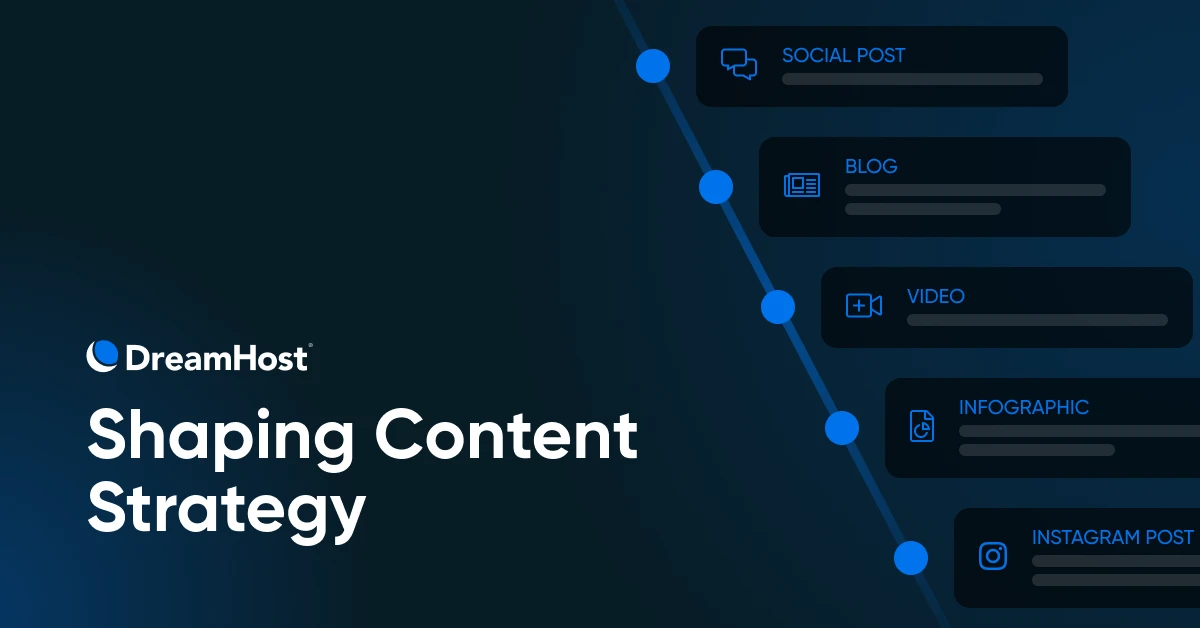
When you run a small business, content marketing can seem a bit…mysterious.
You know the fundamentals: research keywords, create content, and promote it for all you’re worth. But how do you actually get people to read and engage with the content you produce?
There‘s no smoke and mirrors here. And you definitely don’t need to pull any long-eared mammals out of hats.
Here’s a hint: it’s all about strategy.
If you want to steal a march on the competition, you’ve come to the right place. In this guide, we’re going to look at the content marketing strategies that are destined for greatness in 2025 — and beyond.
Ready to jump in? Let’s go!
Why Content Strategy Matters
You probably wouldn’t wander into the wilderness without a map. That’s a sure way to become a bear’s breakfast.
The same idea applies to content marketing. Your strategy is your map and your compass. Without a clear sense of direction, you could be forever walking in circles and not even realize it.
Consider this example: Tom owns a café. He wants to use content to attract more potential customers online.
He starts pumping out articles and videos on various coffee-related topics; the latest trends in latte art or whatever. Some of these pieces of content earn attention. Tom feels like he’s a digital marketing guru.
But what he hasn’t realized is that most of the people who read about his barista techniques don’t live anywhere near his café. His articles are appreciated, but sadly, not by potential customers.
If Tom had developed a content strategy, he would’ve figured out that local coffee drinkers are much more interested in learning that he roasts the beans himself and offers delicious blends you won’t find anywhere else in the county.
You don’t want to be like Tom. You want to be the person with the map and compass.
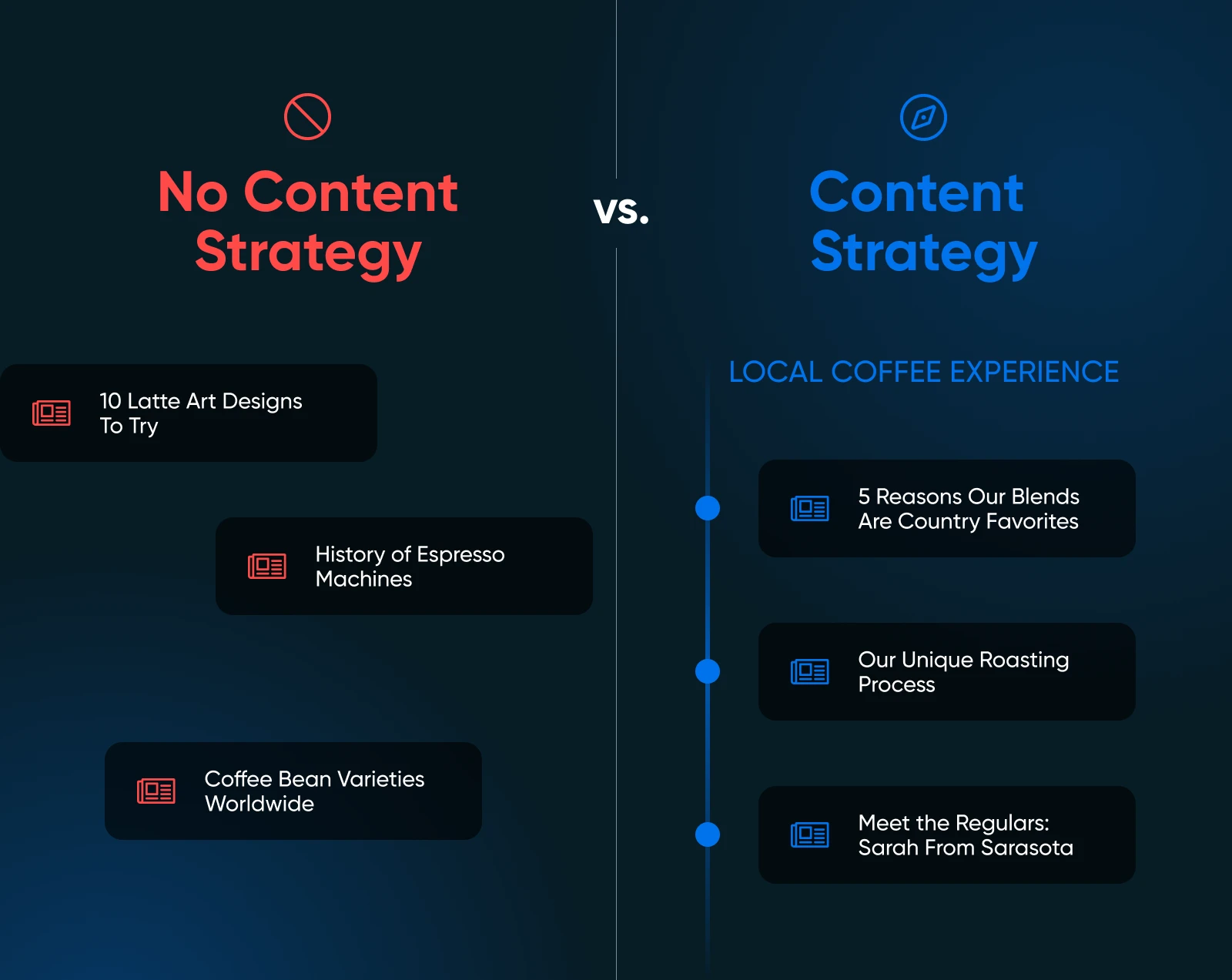
How To Develop a Successful Content Strategy
Developing a sense of direction with your content requires a generous helping of research, a spoonful of deep thought, and a pinch of creativity.
Here are the key concepts to focus on:
Know Your Audience
Who are you creating content for? If you’re thinking “everyone,” pump the brakes. That’s like trying to be everyone’s best friend — it just doesn’t work.
Get specific. Who is your ideal customer? What keeps them awake at night? What makes them tick? The more you know about your audience, the better you can tailor your content to their needs.
It’s worth creating buyer personas: fictional characters that represent your target audience. Give them names, backstories, and favorite ice cream flavors if you want. The more real they feel, the more easily you can imagine what type of content they will enjoy.
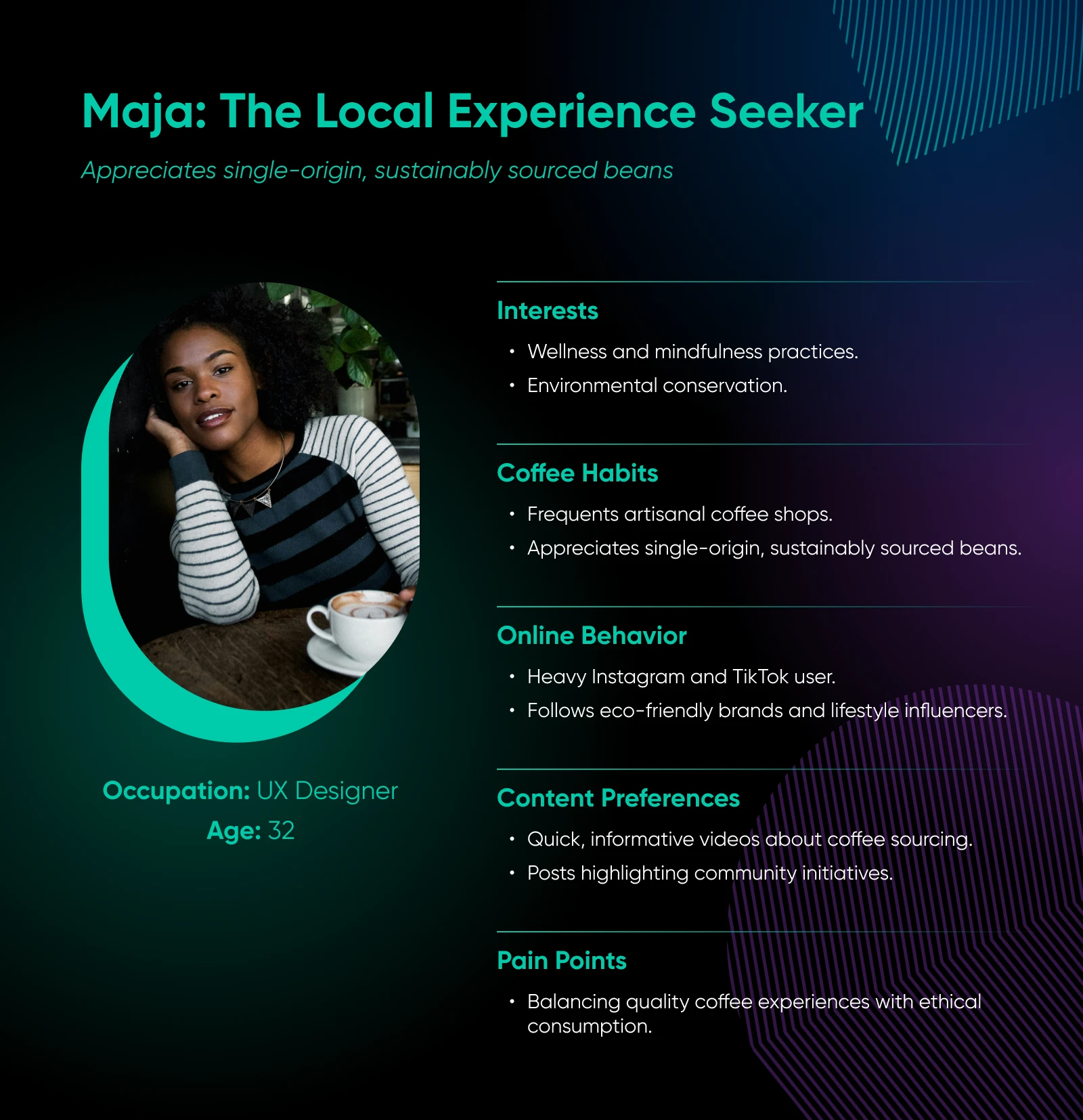
Set Clear Goals
Think about what you want your content to achieve. Is it more website traffic, higher conversion rates, or maybe brand awareness?
Whatever it is, make sure your goals are SMART:
- Specific
- Measurable
- Achievable
- Relevant
- Time-bound
For example, instead of simply “increase website traffic,” try “increase organic website traffic by 25% in the next six months.”
Choose the Right Channels
Great content is nothing without good distribution. If you want to reach your ideal buyers, you need to find out where they hang out online.
Are they Instagram addicts, LinkedIn professionals, or YouTube binge-watchers? Work out where they spend time and meet them there.
Remember, you don’t need to be on every platform. It’s better to nail one or two channels than to spread yourself thin across a dozen.
Create a Content Calendar
Consistency is key in content marketing. One article won’t make a big difference, but weekly posts can drive interest in your brand.
Developing a content calendar can help you to maintain a consistent output. It also ensures you’re not scrambling for ideas at the last minute.
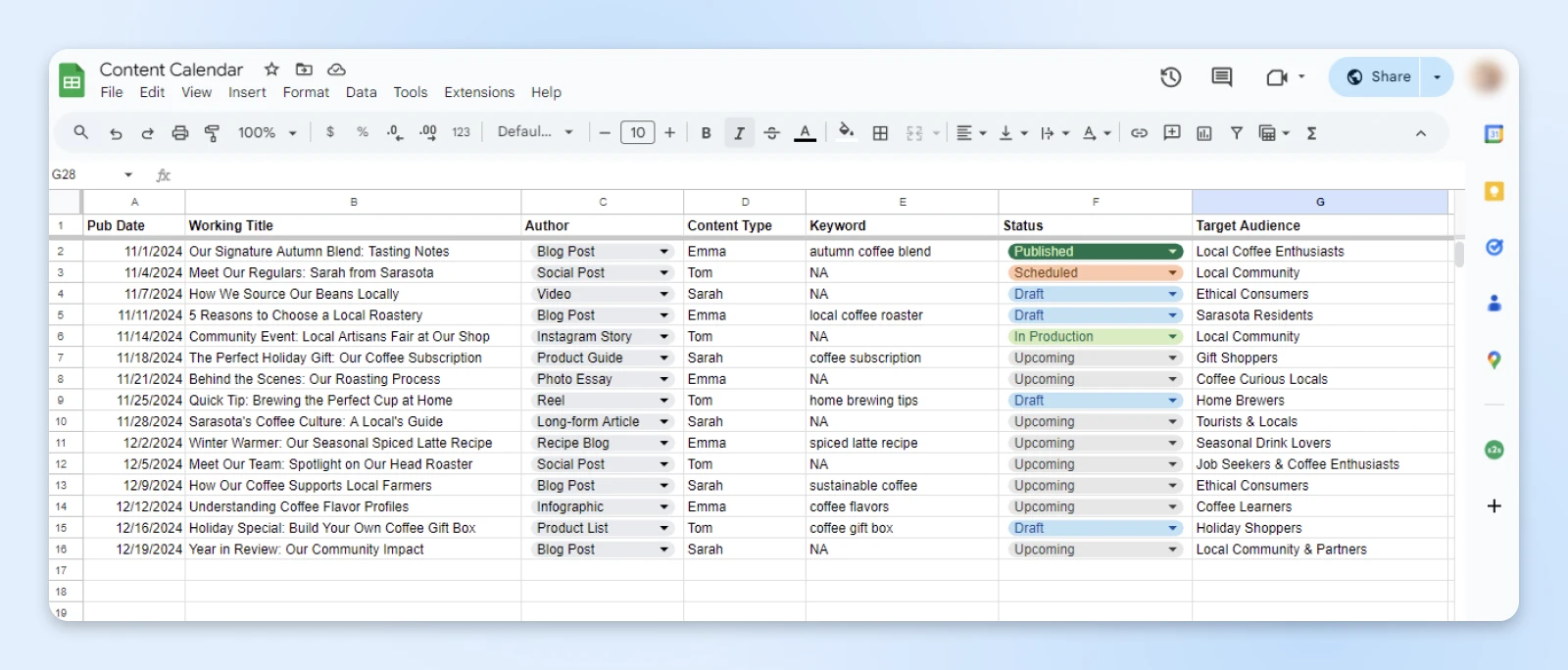
Plan out your content in advance. Mix it up with different types of content like blog posts, videos, infographics — you name it. And here’s a pro tip: take notice of seasonal events, like holidays. (That’s when the plastic comes out.)
Measure and Adjust
Here’s where the rubber meets the road. You need to know if your content strategy is actually working.
Set up analytics to track your key metrics. Are people engaging with your content, and is it driving the results you want? Don’t be afraid to dig into the numbers — they’ll tell you what’s working and what’s not.
And here’s the kicker: be ready to pivot. If something’s not working, change it up. Your content strategy isn’t set in stone.
5 Key Insights To Inform Your 2025 Content Strategy
Sticking with these content commandments should ensure you have a solid start in strategy.
But it’s worth remembering that content marketing is a zero-sum game. If your competitors are better prepared, they will take the traffic. And all those potential customers, too.
Want to give your business an unfair advantage? Here are five emerging trends you need to include in your 2025 content plan.
1. Use AI To Enhance Your Work, Not Automate It
You were probably expecting to see AI on this list. Well, we’re not one to let you down.
The thing is, tools like ChatGPT and Claude can massively enhance your content marketing efforts — you just need to know how to use them properly.
Right now, way too many organizations are using AI tools as a low-effort shortcut. They just ask the model to create content on a certain topic, copy and paste the result, and hit publish.
You end up with really boring, generic content that doesn’t even match your business goals.
It’s better to think of AI as your apprentice. You take the decisions and shape the strategy; the AI can assist your research, chime in with some helpful suggestions, and speed up content creation. Together, you can be a world-class content team!
Here’s a quick look at how you can deploy AI throughout your content marketing process:
Building buyer personas: Provide key details about your ideal customer, and your chosen AI tool will help you flesh out buyer personas. This can help you to construct a clear picture of your target audience.
Example prompt: “I need you to help me build a detailed buyer persona for my content strategy. What information do you need to know in order to create the persona?”
Setting SMART goals: Ask your favorite chatbot to create some SMART goals based on what you hope to achieve with your content marketing efforts. You can use the output as a first draft and adjust it to meet your expectations.
Example prompt: “I want to drive more customers to my café by blogging on my website, and need help on setting achievable goals for my content strategy following the SMART method. Guide me through creating my goals.”
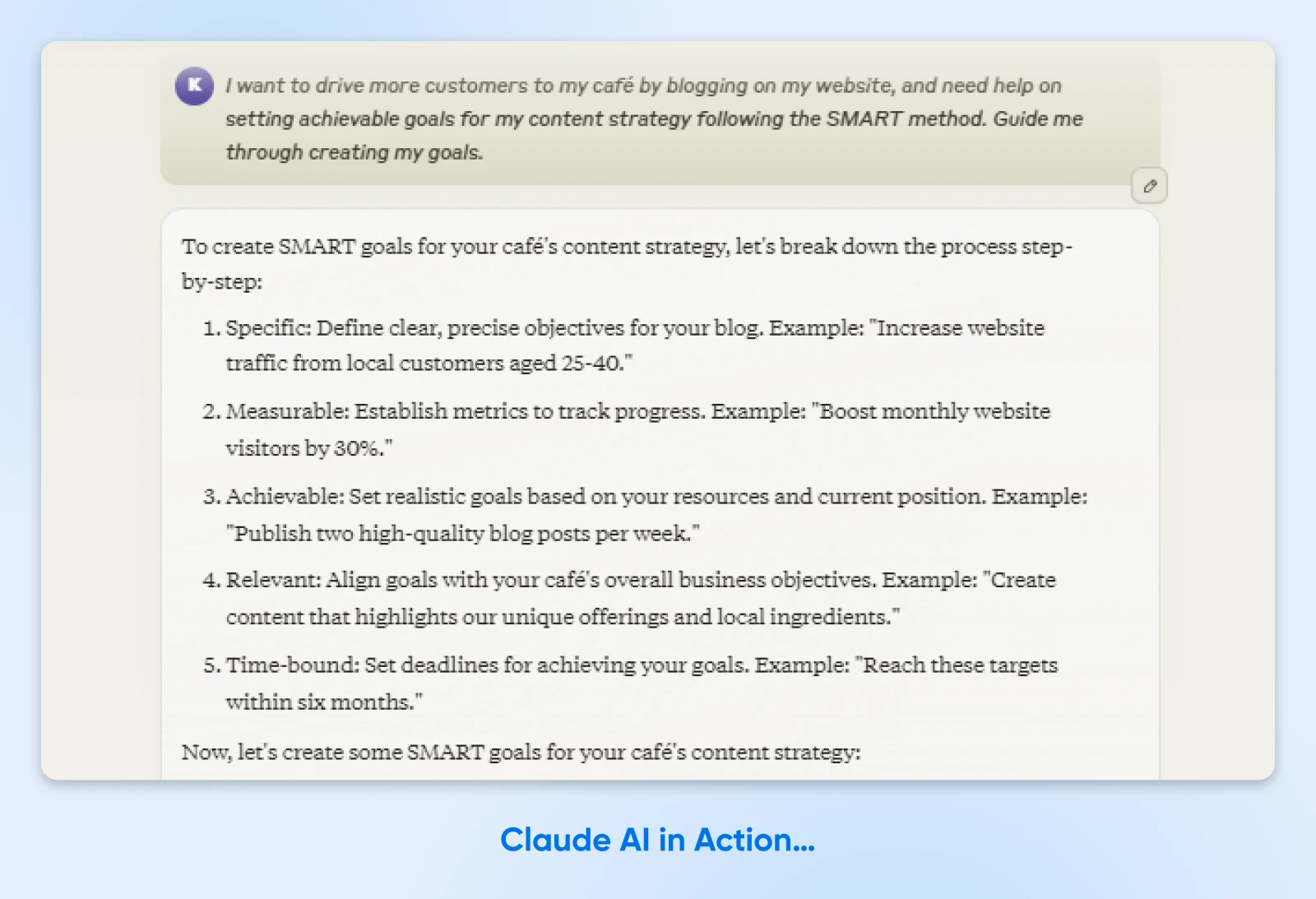
Enhancing content ideation: You can ask your AI assistant to suggest some topics that match your buyer persona and SMART goals. This is a good way to start the process of building out your content calendar.
Example prompt: “I need help with creating a content marketing calendar. Based on the details given below, generate a list of 5 potential blog topics that would be interesting and relevant to the target audience.”Business: [Short description of your business]Goals: [Your SMART goals]Target audience: [Buyer persona]”
Creating content outlines: Once you have chosen a topic you want to cover, AI can help you build a detailed bullet point outline for your piece.
Example prompt: “I need to write an article about [Topic] that covers [Specific Points]. It is aimed at [Buyer Persona] and should [aim of your post]. Please create a detailed bullet point outline for the post that includes all the key points I should try to hit.”
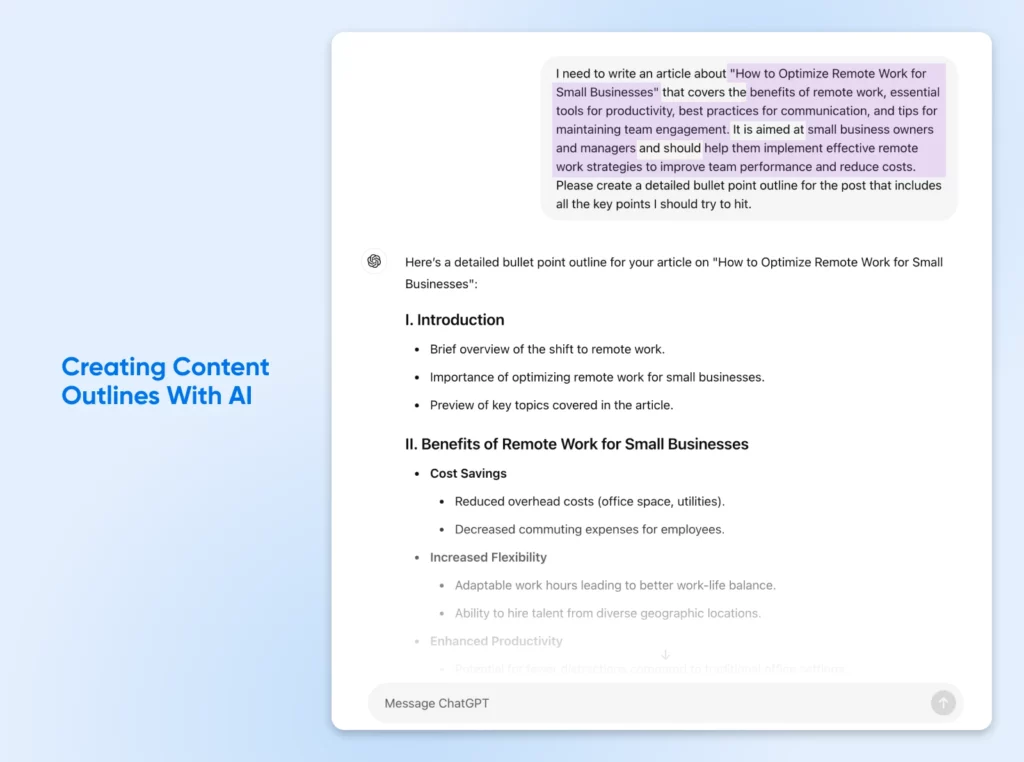
Get help with first drafts: While writing entire blog posts with AI is probably not the best use of the technology right now, you can create sections quite effectively.
Example prompt: “I am writing an article with the following outline. Please create a first draft for the section entitled, [Header here].Outline: [Outline]”
Whip up some graphics: Thanks to the DALL-E integration, ChatGPT can help you produce visual content to share on social media or spruce up blog posts. Just describe what you want!
You can dive deeper into using AI with our guide for small business owners.
2. You Should Probably Start Making Videos
Video is exploding right now:
And that’s just on video platforms. Blog articles that are paired with a matching video generate 70% more traffic on average than articles without.
These are crazy numbers.
As your company’s chief content strategist, you should decide which content types will best serve your target audience. But for the vast majority of audience personas, video is now looking like a good bet.
So, what types of video make for effective content? Here’s the menu:
- Build a brand story: Sharing the backstory of your business is a great way to win the trust of potential customers, and highlight the unique selling points of your offer. Talk about the company’s history, your team, and your process.
- Demonstrate your products: In most cases, it’s easier to show off your product than to explain its benefits. Product videos also make great short-form content. If people like what they see, you could go viral.
- Let your fans do the talking: Try asking your biggest fans to record a short video review or testimonial to share on your website and social channels. This is a powerful form of social proof.
- Share your knowledge: Most customers want an expert to guide them toward a solution. By creating explainer videos about topics in your niche, you can prove your expertise.
- Go behind the scenes: By giving your audience a peek behind the curtain, you make your brand seem more personal and likable.
Remember, you still need to create a content strategy for your videos. Every post should be working toward your goals.
3. Google Is Changing the SEO Game
Just when you thought you had a handle on SEO, Google throws a curveball.
Over the last few months, the search giant has been rolling out AI answers, experimenting with new results page formats, and reshaping website rankings.
Honestly, you probably don’t want to dive too deep into these changes. (We’d recommend leaving this crippling headache to our seasoned SEO experts.)
However, it’s definitely worth noticing the main trends. In fact, you should build your 2025 strategy around them.
- Focus on E-E-A-T: This acronym stands for the four pillars of high-quality content, according to Google: Experience, Expertise, Authoritativeness, and Trustworthiness. In other words, content that provides unique insights from genuine experts is likely to perform better in the long run than generic AI-generated fluff.
- Give the people what they want: Google is starting to reward content that matches the intent of the user, rather than playing to the algorithm. If lots of people visit and then leave your site quite quickly, you can expect a drop in rankings.
- Make it real: Thanks to the rapid spread of generic AI content across the web, Google is now trying to promote real, human authors who are notable in their field. If you can build that kind of online profile, you’re more likely to see your site at the top of search results.
- Don’t forget local SEO: Most people turn to Google when they’re searching for local businesses. Your Google Business Profile (GBP) can help you reach these potential customers right in the search results.
Want to dive deeper into SEO? We’ve written loads of helpful guides:
4. Customers Love Interactive Content
The usual approach to content marketing is a one-way flow of information. You create the content, and potential customers soak it up.
That dynamic is changing, though.
Many brands are now using interactive content to keep website visitors engaged from the moment they arrive. And it’s working really well.
Buyers consume interactive content for 13 minutes on average, compared with 8.5 minutes spent on static content. Plus, studies suggest that interactive content can drive 30% more conversions.
Some of the most common types of interactive content include:
- Quizzes: In return for answering a few short questions, you can offer to guide visitors toward their perfect solution. This mimics the kind of customer service you would expect in a small independent store. It also helps you to direct traffic toward the money!
- Giveaways and contests: Ever visited an online store and been offered the chance to spin a virtual roulette wheel filled with discounts? This is a powerful form of interactive content, commonly used in e-commerce. Some sites also get visitors involved with giveaways — perfect for filling that email list!
- Chatbots: One step up from a simple quiz is to place a virtual rep on your homepage. Chatbots can help new customers learn more about your offer in a familiar instant messaging framework.
- Calculators: You can help your customers to price up their own orders or calculate the savings they can make with your offer.
For example, paint retailer Glidden, has a “paint calculator” to help consumers determine how many cans of paint they need to purchase for a specific space.
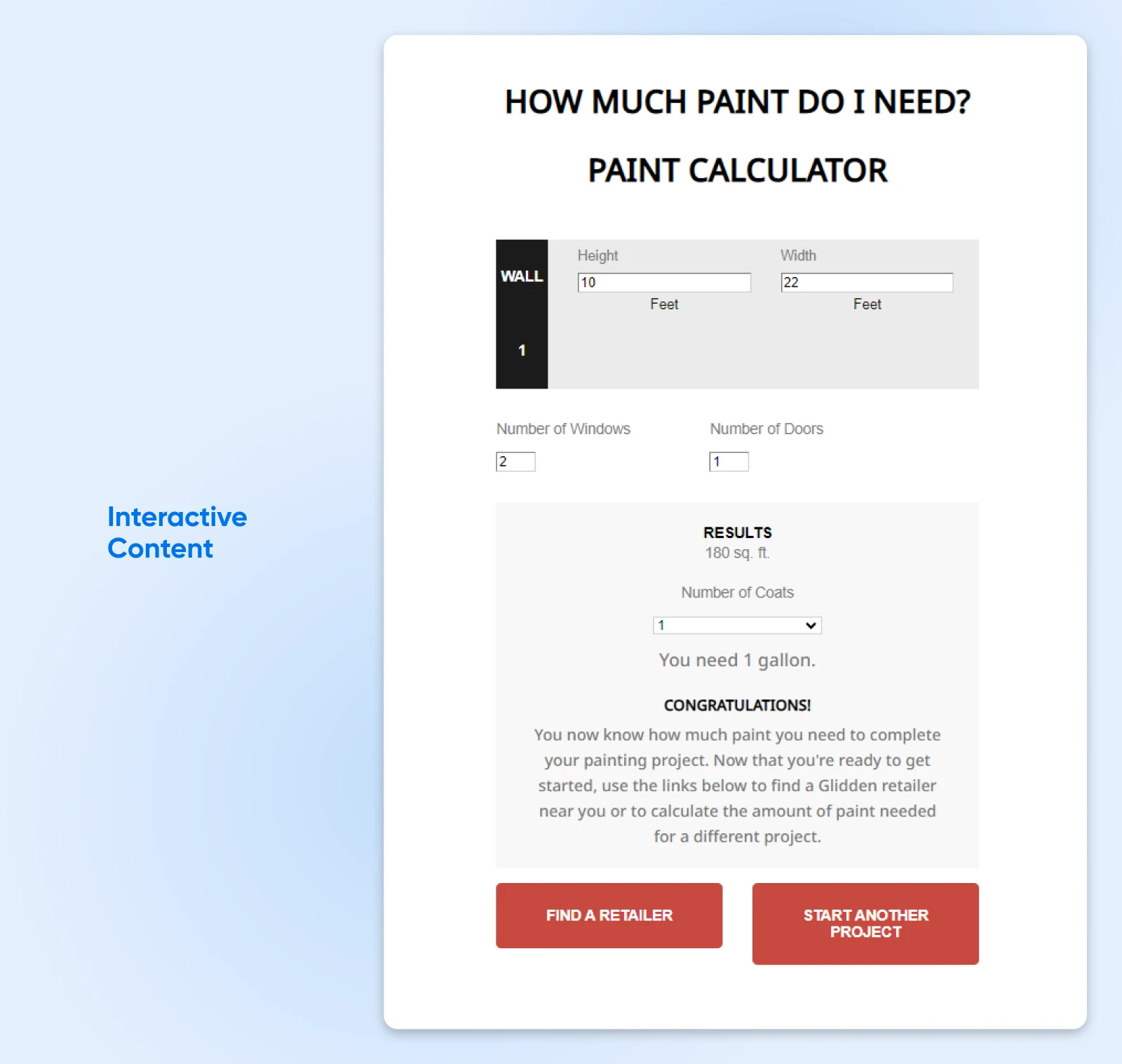
If your site runs on WordPress, you can easily add these features using plugins like WPForms, H5P, Social Boost, and more.
5. Embrace “Zero Click” Content
Humans are pretty lazy by nature. Even the smallest inconvenience can have a dramatic impact on our collective behavior.
And online navigation is the perfect example.
Every time you ask someone to click something, there’s a fair chance they simply won’t bother.
It’s not really the click itself that puts people off. The annoying part is waiting for the new page to load, and then potentially retracing your steps afterward. Clickbait fatigue is definitely a thing, as well.
That’s why plenty of content creators are turning to “zero-click” content.
This is content made specifically for the platforms where your audience spends time. They don’t have to visit a link to engage with your brand — it’s all right there in their feed.
Some examples:
- Instead of writing a blog post and sharing a link on your social feeds, you could publish a post directly on Facebook or LinkedIn.
- Create product videos for your TikTok audience first, and then convert them for your website.
- Share step-by-step tutorials via threads on X.
Zero-click content might not drive as many visitors to your website directly. However, because you’re providing value upfront, you’re much more likely to reach potential customers with your content — meaning your brand has a chance to shine.
Bonus: It’s Time To Review Your Existing Content
Content strategy is an ongoing process. At least once a quarter, you should review the stats and see whether the content you have published is actually hitting the target.
We call this process a content audit.
Putting your previous posts under the microscope can help you to shape your future strategy. It also allows you to adapt existing content to better fit your current approach.
Develop a content management schedule to make sure you don’t forget to check your work regularly.
Stay Agile for Content Marketing Success in 2025
Content strategy is always changing. New content marketing trends are emerging all the time. What was fresh two years ago looks seriously outdated now.
If you want to stay ahead of the curve, it’s essential to keep reviewing your work, analyzing audience data, and monitoring the competition.
Don’t ever be afraid to change the parts of your strategy that aren’t working. Double down on content that’s performing well.
And if you need help? Our marketing and social media experts are at your service! DreamHost customers also get free access to our powerful AI Business Advisor, which can help you power through content tasks.
Finally, don’t forget — great content only shines on solid hosting. With a 100% uptime guarantee on all DreamHost plans, we provide a reliable launchpad for your marketing campaigns.
Sign up today to feel the difference great hosting can make!
This page contains affiliate links. This means we may earn a commission if you purchase services through our link without any extra cost to you.


